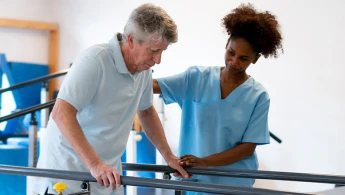Four Stroke Recovery Models to Help Customize Treatment Plans
July 14, 2016
3 min. read

Stroke recovery is a long process that begins during inpatient care. It is critical that practitioners and researchers understand the recovery process from the perspectives of stroke survivors and their family members who will be providing post-discharge care. Several conceptual models are designed to help us better understand the recovery process, allowing us to tailor treatment plans to the needs of both stroke survivors and their caregivers.
1. The ICF
TheICF(International Classification of Functioning, Disability, and Health) is a conceptual model that the World Health Organization developed in 2002 to merge the medical and social models of disability.1While not specific to stroke, this model was designed for measuring health and disability at both individual and population levels.2It can be used as a framework for research and practice with recovering stroke patients. The model includes classifications for Body Function and Structures, Activities, Participation, and Environmental and Personal Factors.
2. Timing it Right
Dr. Jill Camerons Timing it Right framework outlines the phases of stroke recovery from the stroke event through stabilization, preparation, implementation, and adaptation.3It can be used to identify the stroke survivors and caregivers needs across the stroke care continuum, from admission to community re-integration.
3. Mauk Model of Post-Stroke Recovery
Dr. Kris Mauks Model of Post-Stroke Recovery focuses on understanding how stroke survivors integrate the effects of stroke in their self-identify.4The model includes 6 phases of recovery:
Agonizing
Fantasizing
Realizing
Blending
Framing
Owning
The model helps providers understand how stroke affects a patients sense of self, depending on their phase of recovery. Providers can then tailor treatment plans to match the patients emotional recovery from stroke.
4. Stroke Crisis Trajectory
The Stroke Crisis Trajectory shows how stroke survivors and their family caregivers move through the continuum of care, from the stroke event through acute care to inpatient rehabilitation.5The model highlights two crisis points for caregivers and stroke survivors:
The stroke event occurs.
The caregiver realizes they may not be adequately prepared for the caregiving responsibilities at home.
The trajectory helps providers and researchers create discharge plans or interventions that are tailored to meet the needs of both stroke survivors and family caregivers.
Why Do These Models Matter?
The stroke recovery models contribute additional information for providers and researchers to better understand the stroke recovery trajectory. They are valuable resourcesto providers, aiding in the creation of custom treatment and discharge plans or interventions. Both stroke survivors and family caregivers benefit from the recovery models as they allow providers toaddress the needs of both groups throughout eachstage of the recovery process.





